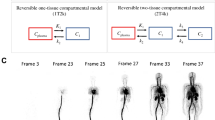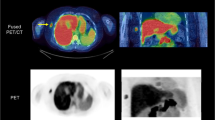Abstract
Introduction
PSMA PET/CT has emerged as imaging modality of choice in the management of Prostate cancer which is useful from theraonostic viewpoint as well. Dynamic PET/CT provides unique advantage of registering pharmacokinetic information. We hereby provide overview of dynamic PET/CT imaging and its potential utility in Prostate Cancer.
Methods
We reviewed existing literature on principles of dynamic PET imaging, tracer kinetic modelling, and studies performed using dynamic imaging in Prostate cancer using appropriate search criteria on PubMed and SCOPUS. Dynamic PET/CT imaging enables the visualization of various aspects of tracer kinetics. Tracer kinetic modelling employs compartments which are macroscopic subsystems in an observed system. Although different protocols of dynamic imaging can be employed, none is proven to be superior to others, and dynamic acquisition for 60 min just after tracer injection is the frequently used protocol in most of the studies for Prostate Cancer. Two tissue compartment modelling-based quantitative evaluation is performed. Images are visualized in qualitative, semiquantitative, quantitative (two-tissue compartment modelling) and fractal analysis. Four rate constants have been described for tracer exchange between plasma and tissue subsequently.
Results
Addition of early dynamic imaging to the routine imaging protocol may increase detection rate for local recurrence in Prostate Cancer. Molecular mapping of static and dynamic images would be helpful in identification of areas of tumor heterogeneity. Dynamic imaging has also the potential to help in planning targeted therapy. It also helps to differentiate pathological activity from the greater physiological bladder activity in delayed static images. Dynamic PET/CT imaging showed increasing tracer uptake during the dynamic PET acquisition as well as high binding and internalization of the PSMA radioligand in the Prostate cancer lesions.
Conclusion
Addition of early dynamic PET/CT imaging in to the routine static protocol after tracer injection has the potential to further improve the diagnostic accuracy and detection rate of local recurrence in PC. Dynamic imaging in Prostate cancer is a largely unexplored arena which may play an important role in evolving optimal in management of Prostate cancer and further larger uniform studies are warranted.



Similar content being viewed by others
References
Hofman MS, Iravani A (2017) Gallium-68 prostate-specific membrane antigen PET imaging. PET Clin 12(2):219–234
Ghafoor S, Burger IA, Vargas AH (2019) Multimodality imaging of prostate cancer. J Nucl Med 60(10):1350–1358
Hodolic M (2011) Role of (18)F-choline PET/CT in evaluation of patients with prostate carcinoma. Radiol Oncol 45(1):17–21
Gusman M, Aminsharifi JA, Peacock JG, Anderson SB, Clemenshaw MN, Banks KP (2019) Review of 18F-fluciclovine PET for detection of recurrent prostate cancer. Radiographics 39(3):822–841
Bostwick DG, Pacelli A, Blute M, Roche P, Murphy GP (1998) Prostate specific membrane antigen expression in prostatic intraepithelial neoplasia and adenocarcinoma: a study of 184 cases. Cancer 82:2256–2261
Oh SW, Cheon GJ (2018) Prostate-specific membrane antigen PET imaging in prostate cancer: opportunities and challenges. Korean J Radiol 19:819–831
Sachpekidis C, Kopka K, Eder M, Hadaschik BA, Freitag MT, Pan L, Haberkorn U, Dimitrakopoulou-Strauss A (2016) 68Ga-PSMA-11 dynamic PET/CT imaging in primary prostate cancer. Clin Nucl Med 41(11):e473–e479
Burger C, Buck A (1997) Requirements and implementation of a flexible kinetic modeling tool. J Nucl Med 38(11):1818–1823
Sachpekidis C, Goldschmidt H, Hose D et al (2014) PET/CT studies of multiple myeloma using (18) F-FDG and (18)F-NaF: comparison of distribution patterns and tracers’ pharmacokinetics. Eur J Nucl Med Mol Imaging 41:1343–1353
Sachpekidis C, Eder M, Kopka K, Mier W, Hadaschik BA, Haberkorn U, Dimitrakopoulou-Strauss A (2016) (68)Ga-PSMA-11 dynamic PET/CT imaging in biochemical relapse of prostate cancer. Eur J Nucl Med Mol Imaging 43(7):1288–1299
Dimitrakopoulou-Strauss A, Pan L, Sachpekidis C (2021) Kinetic modeling and parametric imaging with dynamic PET for oncological applications: general considerations, current clinical applications, and future perspectives. Eur J Nucl Med Mol Imaging 48(1):21–39
Rahmim A, Lodge MA, Karakatsanis NA, Panin VY, Zhou Y, McMillan A, Cho S, Zaidi H, Casey ME, Wahl RL (2019) Dynamic whole-body PET imaging: principles, potentials and applications. Eur J Nucl Med Mol Imaging 46(2):501–518
Muzi M, O’Sullivan F, Mankoff DA, Doot RK, Pierce LA, Kurland BF, Linden HM, Kinahan PE (2012) Quantitative assessment of dynamic PET imaging data in cancer imaging. Magn Reson Imaging 30(9):1203–1215
Samimi R, Kamali-Asl A, Geramifar P, van den Hoff J, Rahmim A (2020) Short-duration dynamic FDG PET imaging: Optimization and clinical application. Phys Med 80:193–200
Sachpekidis C, Pan L, Hadaschik BA, Kopka K, Haberkorn U, Dimitrakopoulou-Strauss A (2018) 68Ga-PSMA-11 PET/CT in prostate cancer local recurrence: impact of early images and parametric analysis. Am J Nucl Med Mol Imaging 8(5):351–359
Uprimny C, Kroiss AS, Decristoforo C, Fritz J, Warwitz B, Scarpa L, Roig LG, Kendler D, von Guggenberg E, Bektic J, Horninger W, Virgolini IJ (2017) Early dynamic imaging in 68Ga-PSMA-11 PET/CT allows discrimination of urinary bladder activity and prostate cancer lesions. Eur J Nucl Med Mol Imaging 44(5):765–775
Uprimny C, Kroiss AS, Fritz J, Decristoforo C, Kendler D, von Guggenberg E, Nilica B, Maffey-Steffan J, di Santo G, Bektic J, Horninger W, Virgolini IJ (2017) Early PET imaging with [68]Ga-PSMA-11 increases the detection rate of local recurrence in prostate cancer patients with biochemical recurrence. Eur J Nucl Med Mol Imaging 44(10):1647–1655
Sachpekidis C, Afshar-Oromieh A, Kopka K, Strauss DS, Pan L, Haberkorn U, Dimitrakopoulou-Strauss A (2020) 18F-PSMA-1007 multiparametric, dynamic PET/CT in biochemical relapse and progression of prostate cancer. Eur J Nucl Med Mol Imaging 47(3):592–602
Uprimny C, Kroiss AS, Decristoforo C, Fritz J, von Guggenberg E, Kendler D, Scarpa L, di Santo G, Roig LG, Maffey-Steffan J, Horninger W, Virgolini IJ (2017) 68Ga-PSMA-11 PET/CT in primary staging of prostate cancer: PSA and Gleason score predict the intensity of tracer accumulation in the primary tumour. Eur J Nucl Med Mol Imaging 44(6):941–949
Marzola MC, Chondrogiannis S, Ferretti A, Grassetto G, Rampin L, Massaro A, Castellucci P, Picchio M, Al-Nahhas A, Colletti PM, Marcolongo A, Rubello D (2013) Role of 18F-choline PET/CT in biochemically relapsed prostate cancer after radical prostatectomy: correlation with trigger PSA, PSA velocity, PSA doubling time, and metastatic distribution. Clin Nucl Med 38(1):e26-32
Dimitrakopoulou-Strauss A, Strauss LG, Heichel T, Wu H, Burger C, Bernd L, Ewerbeck V (2002) The role of quantitative (18)F-FDG PET studies for the differentiation of malignant and benign bone lesions. J Nucl Med 43(4):510–518
Nishimura M, Tamaki N, Matsushima S, Kiba M, Kotani T, Bamba C, Nakamura Y, Yamada K (2020) Dynamic whole-body 18F-FDG PET for differentiating abnormal lesions from physiological uptake. Eur J Nucl Med Mol Imaging 47(10):2293–2300
Henze M, Dimitrakopoulou-Strauss A, Milker-Zabel S et al (2005) Characterization of 68Ga-DOTA-D-Phe1-Tyr3-octreotide kinetics in patients with meningiomas. J Nucl Med 46:763–769
Golan S, Nidam M, Bernstine H, Baniel J, Groshar D (2018) Dynamic 11C-choline PET/CT for the primary diagnosis of prostate cancer. Int Braz J Urol 44(5):900–905
Acknowledgements
Dr. Harmandeep Singh, Nivedita Rana and Priya Sharma, Department of Nuclear Medicine, PGIMER, Chandigarh.
Author information
Authors and Affiliations
Contributions
VKD: (a) conception and design of the article, or acquisition, analysis and interpretation of data; (b) drafting of the article or critical revision for important intellectual content; and (c) final approval of the version to be published. SJ: (b) drafting of the article or critical revision for important intellectual content. PPH: (a) conception and design of the article, or acquisition, analysis and interpretation of data; (b) drafting of the article or critical revision for important intellectual content; and (c) final approval of the version to be published. AKM: (a) conception and design of the article, (b) critical revision for important intellectual content; and (c) final approval of the version to be published. SB: (a) conception and design of the article, (b) critical revision for important intellectual content; and (c) final approval of the version to be published. MKG: (a) conception and design of the article, (b) critical revision for important intellectual content; and (c) final approval of the version to be published.
Corresponding author
Ethics declarations
Conflict of interest
All the authors and co-authors declare no conflict of interest.
Research involving human participants and animals
This article does not contain any studies with human or animal subjects performed by the any of the authors.
Additional information
Publisher's Note
Springer Nature remains neutral with regard to jurisdictional claims in published maps and institutional affiliations.
Rights and permissions
About this article
Cite this article
Dhingra, V.K., Jain, S., Mishra, A.K. et al. Dynamic PET in prostate cancer: basic concepts and potential applications. Clin Transl Imaging 10, 243–248 (2022). https://doi.org/10.1007/s40336-022-00499-4
Received:
Accepted:
Published:
Issue Date:
DOI: https://doi.org/10.1007/s40336-022-00499-4




